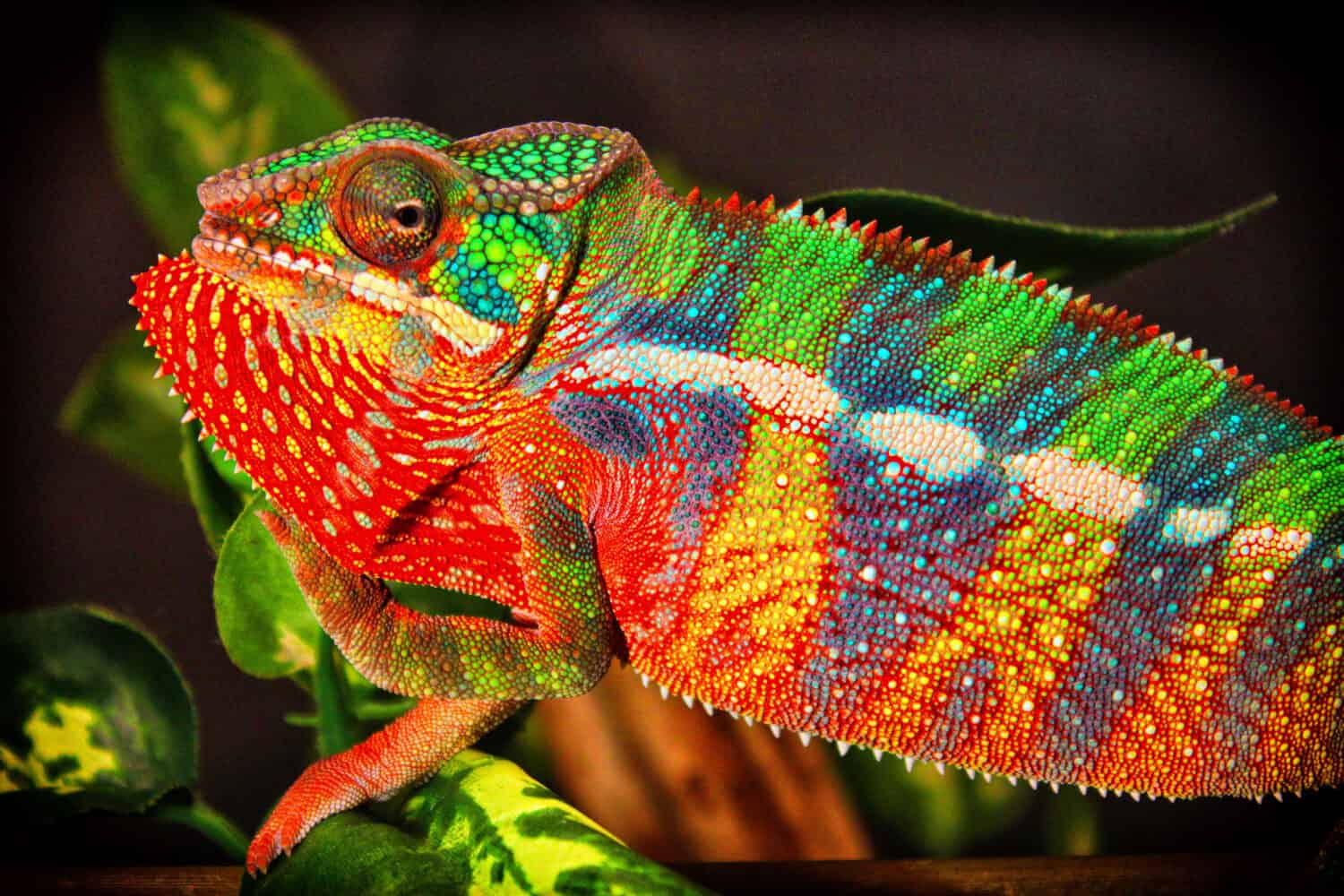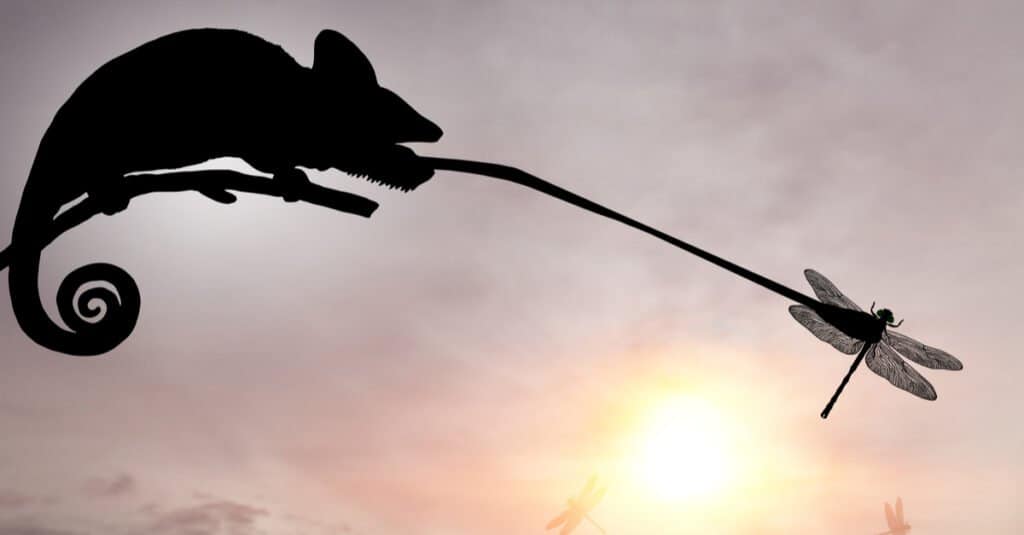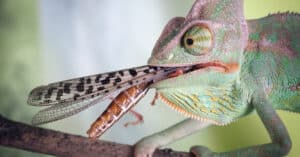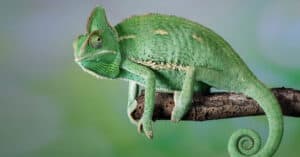Introduction: The Panther Chameleon — A Unique and Colorful Pet Requiring Specialized Care
As reptiles go, chameleons are pretty darn spectacular. These African-native lizards—about half of whom occur only in Madagascar—have some remarkable physical traits to help them thrive in their native arboreal environment. The most famous of these, of course, is the chameleon’s ability to change color. To be clear, it’s a myth that a chameleon can change its skin to match any background. Different chameleon species have specific color ranges that they can adopt, thanks to specialized cells in their skin that release or concentrate pigment. Temperature and light affect a chameleon’s skin color, as does their emotional state. Males can display vivid, complex color patterns during courtship and mating.

The spectacular colors of the panther chameleon make it a favorite pet among reptile lovers.
©Brenton Schappell/Shutterstock.com
And as far as chameleons go, you’d be hard-pressed to find a more fascinating specimen than the panther chameleon, Furcifer pardalis. One of the most colorful reptiles on earth, the panther chameleon can display shades of shades of green, blue, orange, yellow, and red, if male. Females tend to show pale pink, green, or brown coloration. But their changing colors aren’t the only visual pizzazz that these lizards have to offer. Panthers exhibit the full package of chameleon traits including:
Forked feet. Their specialized tong-shaped “zygodactyl” toes help them grasp and climb.
Independent eyes. The turret-like eyes of this chameleon can move and rotate independently of each other. This allows them to see all around themselves with a 360-degree field of vision.
Curly, prehensile tail. Almost a fifth hand, the panther chameleon’s long tail can curl around branches and help them keep their balance.
Super-long, sticky tongue. Panther chameleons catch their prey frog-style, shooting out a super-long tongue with a sticky tip and yanking the food back in a split second.
All in all, the panther chameleon makes a unique, exotic, fascinating, and certainly colorful pet. But as with any animal you add to your household, it’s important to be certain you can give this reptile the care that it needs. Let’s take a closer look at what your panther chameleon will require to stay healthy and happy.
Panther Chameleon Diet: Understanding the Specific Dietary Needs and Feeding Habits

Food on the fly: panther chameleons prefer live prey for their meals.
©Gwoeii/Shutterstock.com
In the wild, panther chameleons are insect eaters, waiting patiently for something edible to come close. Then, ZAP goes that sticky tongue, and it’s snack time. This means your panther will want live prey. Crickets are the typical fare for pet chameleons; they can also be fed mealworms, grasshoppers, cockroaches, and wax worms. Never feed captured insects to your chameleon, as they have been exposed to pesticides. Be sure the food you purchase is gut-loaded, or give the insects fresh food to feed on, so they’ll gain nutrients to pass on to your chameleon. You should also give your chameleon appropriate vitamins and supplements. A juvenile panther chameleon will need about 12 small crickets per day, while adults take 7-10 crickets every other day.
In the wild, panther chameleons lap up water that collects on leaves and plants. So you’ll need to mist their enclosures, or provide a misting/dripper system, so the chameleon can stay properly hydrated.
Pet Care Essentials: Providing the Right Enclosure, Lighting, Temperature, and Humidity for Panther Chameleons

Chameleons like to climb, so be sure to provide branches and perches for your pet panther chameleon.
©Natali art collections/Shutterstock.com
In general, chameleons are challenging reptiles to take care of, so it’s important to plan carefully and make sure you can set up the right environment for your panther chameleon. Their enclosure should be at least 2 ft by 2 ft by 3 or 4 ft, set up vertically so they can climb (the taller the enclosure, the better). Good air circulation is key, so two or more walls of the enclosure should be screen or mesh. Give your chameleon lots of things to climb on: branches, live plants (try pothos and dracaena), and artificial plants.
These reptiles like high humidity (50-70%), so you’ll need to mist the space regularly. A misting or drip system is a good idea, to provide both humidity and drinking water (they won’t drink from a bowl). Keeping plants in and around the enclosure helps maintain the humidity.
Panther chameleons need a basking light to help them keep warm, and an ultraviolet light (UVA/UVB) to help them metabolize calcium. The ambient temperature of their enclosure should be around 75 degrees, with a basking spot that stays at 90 degrees.
Cost Considerations: Exploring the Initial and Ongoing Expenses of Owning a Panther Chameleon
Setting up and maintaining the proper habitat for your panther chameleon is no small investment. You’re trying to replicate a rainforest environment, after all. And the lizard itself does not come cheap—It’s a chameleon, not a comecheapleon. Expect to spend $600 or more for an adult panther chameleon. All of which is to say, take a careful look at your budget before you buy. Be sure you have the resources before you commit to this or any pet. By the way, be sure you buy a chameleon that’s captive-bred. Wild-caught chameleons have more health problems and are shorter-lived.
Important Facts and Tips: Essential Information on Handling, Socialization, and Health Care for Panther Chameleons
Common health problems that affect panthers and other chameleons include stress, eye infections, parasites, kidney failure, and gout. Not all veterinarians are able to treat lizards, so make sure to find a lizard-savvy vet in your area before adopting a chameleon.
Metabolic Bone Disease (MBD), in which bone tissue thins and weakens, is a common health problem among panther chameleons. Symptoms include bow-leggedness, problems climbing or walking, and a crooked jaw or back. A poor diet or lack of UVB light can lead to these issues.
Panther chameleons are highly territorial and can be aggressive with each other. So you should keep only one chameleon in a single enclosure.
The photo featured at the top of this post is © Kurit afshen/Shutterstock.com
Thank you for reading! Have some feedback for us? Contact the AZ Animals editorial team.







